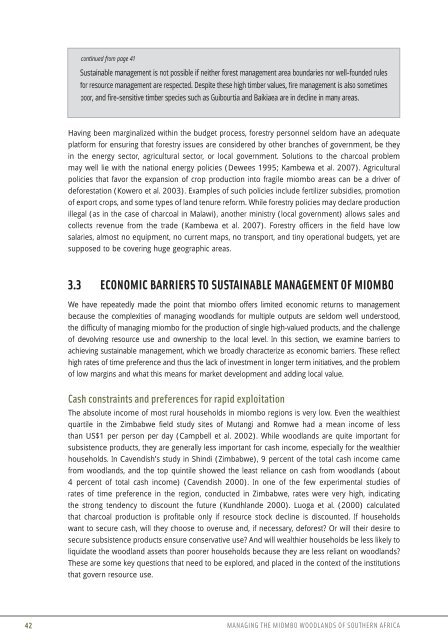Managing the Miombo Woodlands of Southern Africa - PROFOR
Managing the Miombo Woodlands of Southern Africa - PROFOR
Managing the Miombo Woodlands of Southern Africa - PROFOR
You also want an ePaper? Increase the reach of your titles
YUMPU automatically turns print PDFs into web optimized ePapers that Google loves.
continued from page 41<br />
Sustainable management is not possible if nei<strong>the</strong>r forest management area boundaries nor well-founded rules<br />
for resource management are respected. Despite <strong>the</strong>se high timber values, fire management is also sometimes<br />
poor, and fire-sensitive timber species such as Guibourtia and Baikiaea are in decline in many areas.<br />
Having been marginalized within <strong>the</strong> budget process, forestry personnel seldom have an adequate<br />
platform for ensuring that forestry issues are considered by o<strong>the</strong>r branches <strong>of</strong> government, be <strong>the</strong>y<br />
in <strong>the</strong> energy sector, agricultural sector, or local government. Solutions to <strong>the</strong> charcoal problem<br />
may well lie with <strong>the</strong> national energy policies (Dewees 1995; Kambewa et al. 2007). Agricultural<br />
policies that favor <strong>the</strong> expansion <strong>of</strong> crop production into fragile miombo areas can be a driver <strong>of</strong><br />
deforestation (Kowero et al. 2003). Examples <strong>of</strong> such policies include fertilizer subsidies, promotion<br />
<strong>of</strong> export crops, and some types <strong>of</strong> land tenure reform. While forestry policies may declare production<br />
illegal (as in <strong>the</strong> case <strong>of</strong> charcoal in Malawi), ano<strong>the</strong>r ministry (local government) allows sales and<br />
collects revenue from <strong>the</strong> trade (Kambewa et al. 2007). Forestry <strong>of</strong>fi cers in <strong>the</strong> fi eld have low<br />
salaries, almost no equipment, no current maps, no transport, and tiny operational budgets, yet are<br />
supposed to be covering huge geographic areas.<br />
3.3 ECONOMIC BARRIERS TO SUSTAINABLE MANAGEMENT OF MIOMBO<br />
We have repeatedly made <strong>the</strong> point that miombo <strong>of</strong>fers limited economic returns to management<br />
because <strong>the</strong> complexities <strong>of</strong> managing woodlands for multiple outputs are seldom well understood,<br />
<strong>the</strong> diffi culty <strong>of</strong> managing miombo for <strong>the</strong> production <strong>of</strong> single high-valued products, and <strong>the</strong> challenge<br />
<strong>of</strong> devolving resource use and ownership to <strong>the</strong> local level. In this section, we examine barriers to<br />
achieving sustainable management, which we broadly characterize as economic barriers. These refl ect<br />
high rates <strong>of</strong> time preference and thus <strong>the</strong> lack <strong>of</strong> investment in longer term initiatives, and <strong>the</strong> problem<br />
<strong>of</strong> low margins and what this means for market development and adding local value.<br />
Cash constraints and preferences for rapid exploitation<br />
The absolute income <strong>of</strong> most rural households in miombo regions is very low. Even <strong>the</strong> wealthiest<br />
quartile in <strong>the</strong> Zimbabwe fi eld study sites <strong>of</strong> Mutangi and Romwe had a mean income <strong>of</strong> less<br />
than US$1 per person per day (Campbell et al. 2002). While woodlands are quite important for<br />
subsistence products, <strong>the</strong>y are generally less important for cash income, especially for <strong>the</strong> wealthier<br />
households. In Cavendish’s study in Shindi (Zimbabwe), 9 percent <strong>of</strong> <strong>the</strong> total cash income came<br />
from woodlands, and <strong>the</strong> top quintile showed <strong>the</strong> least reliance on cash from woodlands (about<br />
4 percent <strong>of</strong> total cash income) (Cavendish 2000). In one <strong>of</strong> <strong>the</strong> few experimental studies <strong>of</strong><br />
rates <strong>of</strong> time preference in <strong>the</strong> region, conducted in Zimbabwe, rates were very high, indicating<br />
<strong>the</strong> strong tendency to discount <strong>the</strong> future (Kundhlande 2000). Luoga et al. (2000) calculated<br />
that charcoal production is pr<strong>of</strong>i table only if resource stock decline is discounted. If households<br />
want to secure cash, will <strong>the</strong>y choose to overuse and, if necessary, deforest Or will <strong>the</strong>ir desire to<br />
secure subsistence products ensure conservative use And will wealthier households be less likely to<br />
liquidate <strong>the</strong> woodland assets than poorer households because <strong>the</strong>y are less reliant on woodlands<br />
These are some key questions that need to be explored, and placed in <strong>the</strong> context <strong>of</strong> <strong>the</strong> institutions<br />
that govern resource use.<br />
42 MANAGING THE MIOMBO WOODLANDS OF SOUTHERN AFRICA

















